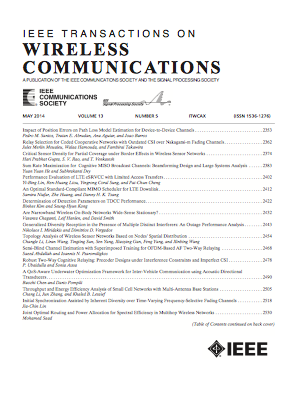MIMO云无线接入网络中的空中联合学习
IF 10.7
1区 计算机科学
Q1 ENGINEERING, ELECTRICAL & ELECTRONIC
引用次数: 0
摘要
为了解决传统空中联邦学习(OA-FL)服务器覆盖范围有限的问题,我们提出了一种新的基于MIMO的云无线接入网络(cloud - ran)的OA-FL框架,称为MIMO cloud - ran OA-FL (MIMOCROF)。拟议的外援部队在每一轮训练中分为三个阶段。边缘聚合的第一阶段允许每个接入点(AP)从边缘设备收集本地更新,并使用MIMO多址访问构造边缘更新。在全局聚合的第二阶段,云服务器(CS)通过前传网络将ap接收到的边缘更新进行聚合,形成全局更新。在模型更新和广播的第三阶段,CS将更新后的全局模型参数发送给ap, ap再将参数广播到它们所服务的设备。为了有效地利用ap间的相关性,我们将全局聚合阶段建模为有损分布式源编码(L-DSC)问题。基于速率畸变理论,进一步分析了MIMOCROF框架的性能。为了提高系统性能,我们提出了一个考虑ap间相关性的通信学习优化问题。为了解决这一问题,我们开发了一种采用交替优化(AO)和最大化最小化(MM)的算法。此外,我们提出了一个实用的L-DSC,利用ap间的相关性。数值结果表明,本文提出的实用L-DSC有效地利用了ap间的相关性,在性能上优于其他基准方案。本文章由计算机程序翻译,如有差异,请以英文原文为准。
Over-the-Air Federated Learning in MIMO Cloud Radio Access Networks
To address the limited server coverage of traditional over-the-air federated learning (OA-FL), we propose a new OA-FL framework for MIMO-based cloud radio access network (Cloud-RAN), called MIMO Cloud-RAN OA-FL (MIMOCROF). The proposed MIMOCROF consists of three stages in each training round. The first stage of edge aggregation allows each access point (AP) to collect local updates from edge devices and construct an edge update using MIMO multiple access. In the second stage of global aggregation, the cloud server (CS) aggregates edge updates received from the APs to form a global update through a fronthaul network. In the third stage of model updating and broadcasting, the CS sends the updated global model parameters to the APs, and the latter then broadcast the parameters to their served devices. To effectively exploit inter-AP correlation, we model the global aggregation stage as a lossy distributed source coding (L-DSC) problem. Based on the rate-distortion theory, we further analyze the performance of the MIMOCROF framework. We formulate a communication-learning optimization problem to improve the system performance by considering the inter-AP correlation. To solve this problem, we develop an algorithm by using alternating optimization (AO) and majorization-minimization (MM). Furthermore, we propose a practical L-DSC that exploits inter-AP correlation. Numerical results show that the proposed practical L-DSC effectively utilizes inter-AP correlation and is superior to other baseline schemes in performance.
求助全文
通过发布文献求助,成功后即可免费获取论文全文。
去求助
来源期刊
CiteScore
18.60
自引率
10.60%
发文量
708
审稿时长
5.6 months
期刊介绍:
The IEEE Transactions on Wireless Communications is a prestigious publication that showcases cutting-edge advancements in wireless communications. It welcomes both theoretical and practical contributions in various areas. The scope of the Transactions encompasses a wide range of topics, including modulation and coding, detection and estimation, propagation and channel characterization, and diversity techniques. The journal also emphasizes the physical and link layer communication aspects of network architectures and protocols.
The journal is open to papers on specific topics or non-traditional topics related to specific application areas. This includes simulation tools and methodologies, orthogonal frequency division multiplexing, MIMO systems, and wireless over optical technologies.
Overall, the IEEE Transactions on Wireless Communications serves as a platform for high-quality manuscripts that push the boundaries of wireless communications and contribute to advancements in the field.

 求助内容:
求助内容: 应助结果提醒方式:
应助结果提醒方式:


